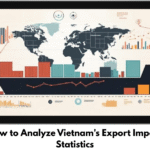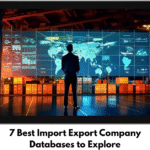In today’s hyper-connected digital ecosystem, data-driven marketing has evolved from a competitive advantage to an operational necessity. Whether you’re running cross-border marketing initiatives or managing large-scale data transfers between platforms, understanding how to optimize your import export campaign keywords is essential for maintaining efficiency and ensuring maximum campaign performance. Efficient keyword optimization not only improves your targeting but also optimizes automation workflows, resulting in enhanced return on investment on platforms like Adobe Campaign Classic, Facebook Ads Manager, and Adobe Campaign Standard.
The Increasing Data and Campaign Complexity
The marketing universe runs on accuracy. import export campaign keywords With each click, interaction, and conversion, a data point is registered — and keeping up with that deluge of data demands an organized import-export approach. Companies no longer are bound by regional silos of data; they run on continents, platforms, and systems. That is where optimized import export campaign keywords come into the picture — assisting marketers in planning global campaigns that fit together beautifully with business and audience objectives.
Think of a business that employs an Import export campaign sample to synchronize email automation tools and CRM leads. Without defined parameters and structured keywords, this data exchange can become disjointed, with the result being mis-targeting and budget waste. import export campaign keywords Keyword optimization, on the other hand, performs as the glue that holds things together so the right person gets the right message at the right time.
Why Keyword Optimization is Important in Import-Export Campaigns
Today’s marketers work with complex systems that need to communicate properly. import export campaign keywords Whether utilizing Import workflow within Adobe Campaign Classic or running a Cm360 import, each step relies on proper keyword tagging and segmentation of data. Inefficiently optimized campaigns can cause out-of-sync reports, redundant entries, or even compliance issues from miscalculated user data. Discover high-performing import-export campaign keywords to target global buyers, boost online visibility, and drive qualified leads for your trade business.
The problem isn’t so much about dealing with the amount of data — it’s about putting that data into context. Keywords serve as identifiers for the data, linking campaigns across platforms and guaranteeing that your audience segmentation is the same every time. import export campaign keywords
When executing international campaigns, localization presents an extra level of sophistication. For example, bringing demographics from Asia and sending engagement outcomes to European analytics platforms involves repeated keyword mapping. A properly designed Import export campaign template not only streamlines these switches but also enhances data accuracy and performance measurement. Discover high-performing import-export campaign keywords to target global buyers, boost online visibility, and drive qualified leads for your trade business.
Bridging Platforms and Campaign Data
To fully optimize your campaigns, understanding how various systems handle data import and export is crucial. Platforms like Adobe Campaign Classic and Adobe Campaign Standard offer flexible workflows, but their efficiency depends heavily on how keywords are configured. import export campaign keywords
For instance, in Import data in Adobe Campaign Classic, CSV or XML formats can be used by marketers to import heavy quantities of audience data. Defining and classifying data through meaningful keywords here enhances the granularity of targeting. This way, when data is subsequently exported — whether to update CRM or optimize ad — the system is maintained with contextual integrity. Discover high-performing import-export campaign keywords to target global buyers, boost online visibility, and drive qualified leads for your trade business.
Likewise, exporting from Facebook Ads Manager with structured keywords makes it simpler to integrate into third-party analytics platforms. By using consistent tags on campaign performance metrics like impressions, click-through rates, and conversions, you can tie social ad performance directly to email and web engagement metrics. import export campaign keywords
At the same time, marketers of Cm360 import processes — commonly employed in Campaign Manager 360 display advertising — can also gain from keyword consistency. Well-labeled data enables teams to track campaign performance from impression through conversion, giving them actionable insights that fuel smarter, faster decision-making.
Building a Unified Framework for Data Movement
One of the most pressing questions marketers have is: How do you export and import a template without losing campaign structure or contextual relevance? The solution is strategic keyword architecture. By creating normalized naming conventions and tagging hierarchies, marketers are able to guarantee each dataset remains complete and coherent throughout shifts.
Think of the contrast between an unoptimized data import and a keyword-optimized one. In the first, fields of data can overlap, resulting in analytics inconsistency. import export campaign keywords In the second, each dataset imported is logically connected to its source and intent. A neatly organized Import export campaign template acts as both map and protection, minimizing human fault and making it easier to audit future campaigns. Discover high-performing import-export campaign keywords to target global buyers, boost online visibility, and drive qualified leads for your trade business.
With these streamlined templates combined with automation in Adobe Campaign Standard, marketing professionals can tap into levels of efficiency never before possible. For example, workflows for Import workflow in Adobe Campaign Classic can auto-classify leads, monitor user behavior, and apply scoring models — all based on keyword-driven logic. This results in seamless continuity from campaign setup to audience segmentation, saving time and helping with sustained consistency. import export campaign keywords
In addition, keyword optimization increases compliance and governance. Privacy laws like GDPR necessitate that organizations have clear records of user consent and communication preferences. With a clearly defined keyword structure built into your import-export strategy, all interactions are traceable and auditable — a most valuable benefit in the current regulatory environment.
Applying Keyword Optimization in Practice
Import export campaign keyword optimization is more than mere tagging — it’s creating an easily scalable ecosystem. Here are practical steps for marketers and data teams to take to improve their import-export operations:
1. Standardize Your Templates
Prior to running campaigns, establish a master Import export campaign template that specifies naming conventions for fields, metrics, and audience identifiers. This way, whenever you transfer data between systems such as Adobe Campaign Standard or Facebook Ads Manager, consistency is achieved.
2. Use Automation Tools Strategically
Leverage automated tools in Adobe Campaign Classic to automate recurring import workflows. Apply rule-based triggers based on keyword patterns for personalization and segmentation. This reduces human error while enhancing operational velocity.
3. Unify Data Across Platforms
Integrate your social, CRM, and analytics data by synchronizing keyword patterns. For instance, when you’re exporting data from Facebook Ads Manager, match your audience tags to those in your Cm360 import system for effortless campaign alignment. import export campaign keywords
4. Continuously Monitor and Refine
Keyword optimization is not a set-it-and-forget-it task. Perform periodic audits of your import-export logs to detect discrepancies, missed tags, or duplicate keywords. With repeated cycles, data quality and campaign performance improve over time.
5. Use Advanced Reporting
Tools such as Adobe Campaign Standard provide customizable dashboards that display keyword-driven performance visually. Employ these insights to improve targeting, maximize ROI, and streamline cross-channel coordination. import export campaign keywords
The Future of Campaign Optimization
With the growing complexity of marketing ecosystems, the need for keyword optimization in data import and export processes will continue to increase. Where CRM systems, ad platforms, and marketing automation tools are converging, there must be a unified approach to data structuring. With an appropriate strategy, fragmented datasets can be merged into unified marketing intelligence.
Optimizing import export campaign keywords is not only about efficiency, but also about control. It provides marketers with the means to control data flow, maintain consistency, and glean valuable insights from each byte of data. From designing templates that outline your data journey to using automation that imposes consistency, each step leads towards smarter, faster, and more scalable campaigns. import export campaign keywords
FAQs on Import Export Campaign Keywords
Q1. What are import-export campaign keywords?
Import-export campaign keywords are search terms used in Google Ads to target global buyers and sellers in international trade and logistics.
Q2. How do I find the best keywords for my import-export business?
Use tools like Google Keyword Planner or SEMrush to find high-traffic, low-competition keywords relevant to your products and target countries.
Q3. Why are keywords important for import-export campaigns?
The right keywords help your ads reach potential buyers, improve ad quality scores, and increase return on investment (ROI). import export campaign keywords
Q4. What are some top-performing import-export keywords?
Examples include “global buyers database,” “export leads India,” “international B2B trade,” and “customs data services.”
Q5. How often should I update my import-export keywords?
Review and update your keyword list monthly to stay aligned with changing trade trends and improve campaign performance.



